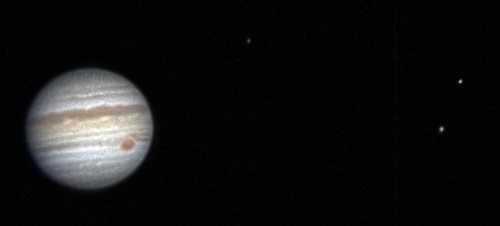The Basics of Planetary Imaging
If you view planets through a telescope you will notice that as the atmospheric conditions change the planet can sometimes flicker into clarity, but most of the time it wobbles and may be much less than clear. This is caused by the seeing – distortions caused by the atmosphere. In the past this made imaging the planets difficult with film cameras.
The advent of digital cameras allowed the development of a new approach called Lucky Imaging, which takes advantage of planets being bright, so you can capture thousands of images of a planet in a few minutes. Once you have captured a video of a planet you can use special software to choose the best frames (usually those when the seeing conditions were steadiest). The software then stacks the chosen images to average them out, reducing the noise in the image and boosting the details. A final stage is to use advanced sharpening techniques to remove residual blurring of the image.

This image of Jupiter with a wide field of view to include the moons Callisto, Ganymede and Io is an example of what can be achieved with relatively modest equipment. More examples of planetary imaging can be found at the Solar System page.
The cheapest way to get into planetary imaging is to buy a cheap adaptor to attach an ordinary webcam to a relatively long focal length telescope. Typically, you might use a relatively large aperture reflector or catadioptric telescope with a long focal length. You might also use a Barlow lens to increase the magnification to be working at an effective focal length of three or four metres. Because the planets are bright you can still use short exposures, so it is not essential to use a tracking mount, although basic tracking does make life a lot easier.
Naturally, like every aspect of astrophotography, planetary imaging is addictive, and you may soon find yourself on an annual quest to get better images of the planets than the last years!
Typical upgrades include specialised planetary cameras and filters or an ‘atmospheric dispersion corrector’ a clever optical device that cancels out blurring of the images by refraction when planets are low in the sky.
If you would like to learn more about how to take planetary images, why not join the RAG astrophotography group?
Here are some examples cut from larger, longer videos of Jupiter taken through a relatively inexpensive Skywatcher 150PL telescope fitted with a x3 Barlow and an atmospheric dispersion corrector and captured using a ZWO ASI120MC camera and 'Sharpcap' software. The first video shows what to expect in poor seeing:
This second video was taken a couple of nights later under much better conditions:
The image further up this page is the result of stacking and processing some of the video captured on the second evening.
